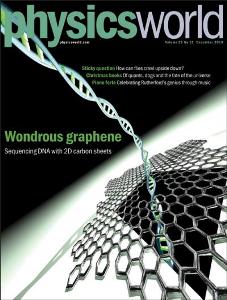Dec 2 2010
Genome sequencing will have a profound effect on our understanding of genetic biology and could usher in a day when doctor and patient are able to review individual genome sequences to fully personalise medical treatment.
As the X PRIZE FOUNDATION begins to receive nominations for its $10m prize for the first privately funded company that can accurately sequence 100 genomes in 10 days for less than $10,000 per genome, the science writer Philip Ball looks at the latest advances towards success in December Physics World's lead feature.
 This is the cover of Physics World.
This is the cover of Physics World.
The baton, once firmly in the hands of chemists and biologists, has been grabbed by physicists around the world since the mid-1990s when David Deamer from the University of California, Santa Cruz imagined threading a DNA strand through a tiny pore -- reading out the chemical bases strung along the strand as it passes through. His idea was that in a salt solution, the number of dissolved ions passing through the pore would vary depending on which base was sitting in the pore.
Over the past decade, scientists have sought means to use Deamer's technique with far greater control of the pore and the movement of DNA through the pore, while also contemplating how the technique can be turned into a handy device that could be used in doctors' surgeries worldwide.
Initial thoughts were towards the use of a silicon-nitride nanopore but researchers have found the material a little too thick, meaning that more than one nucleotide -- the structural units that make up DNA -- can be in the pore at any one time.
Now, however, graphene -- one-atom thick sheets of carbon that led to this year's Nobel Prize for Physics -- is generating huge excitement as a possible DNA sequencing material following the work of three independent research groups earlier this year.
The teams -- based at the universities of Delft, Pennsylvania and Harvard -- have each drawn DNA through a nanopore drilled into graphene. As the materials is so much thinner than silicon nitride, the teams are reported to believe that graphene may be a "game changer".
Whether for the physicists it's the lure of a $10m prize, the joy of basic research, or the satisfaction of designing a technique that could revolutionize medicine, it looks like graphene -- already dubbed a "wonder material on account it being ultrathin, ultrastrong and a great electrical conductor -- could be adding one more string to its already powerful bow.
Source: http://www.iop.org/